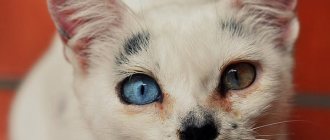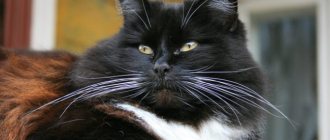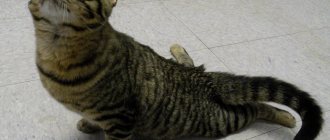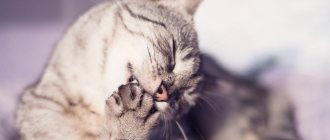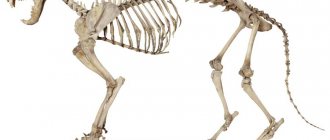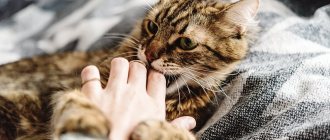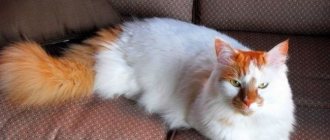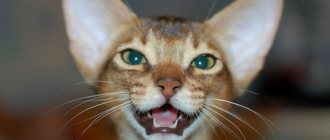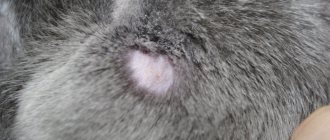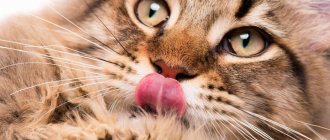From time to time, many owners may notice that their cat's tail has become excessively greasy and does not look very pleasant. Hygiene procedures help, but for a short time. The cat's greasy tail becomes unkempt again. What is the reason? The answer to this question can be found in our article.
Tail ulcer
Short-haired cats often suffer from ulcers that form on their tails.
These ulcers can be located throughout the tail, including at the root of the tail, which can cause necrosis of the vertebrae of the caudal process. This disease is specific and requires strict pharmacological treatment, as well as special recommendations to the owner for treating the cat at home. The process of treating a tail ulcer also includes cleaning it of dirt and, if formed, a crust. After this procedure, the affected area of the tail should be treated with antiseptic powder and lubricated with a special product prescribed by the veterinarian. Kubatol aerosol is often used for these purposes. After such treatment, the affected area is lubricated with ointment. This can be syntomycin or streptomycin ointment, or liquid Vishnevsky liniment. After treatment, the affected area of the tail should be wrapped with a light bandage for 5 days for protection.
All this time, you need to periodically comb the fur in areas located near the affected area to prevent itching. During the procedures, it is better to protect yourself with the help of a protective circle or a “plant pot” type muzzle.
Any tail disease can only be treated under the supervision of a veterinarian.
If this disease is neglected, your pet may develop gangrene. Therefore, when you first suspect the appearance of an ulcer, you need to take the necessary measures without delay. Otherwise, a situation may arise in which there is no other choice but to amputate the tail.
Symptoms of the disease
Fat tails are much more common in male cats than in male cats. As noted above, animals with short fur are at risk, which complicates the diagnostic process. Let's try to find out what signs clearly demonstrate this disease:
- The epithelium at the base of the fur becomes lumpy, it flakes off and becomes covered with a thin crust of pus.
- The tail, most often at the junction with the body, is thickly covered with fat, which makes the fur begin to shine. The discharge cannot be washed off with shampoo or soap.
- If the disease progresses, the skin at the site of localization will be combed and covered with red pimples. This is how the animal tries to relieve the itching, but only spreads the infection through the skin.
- The area of “greasy” fur becomes exposed over time. This is due to the fact that the hairs gradually break off at their base.
- A symptom that the anus is inflamed may be uncharacteristic behavior when the cat crawls with its butt on the carpet, trying to release excess contents.
- Over time, brown spots may appear on your pet's tail; if left untreated, they will develop into a hard crust, tearing which the cat will injure itself.
Owners who notice that their animal has developed “greasy tail” syndrome should under no circumstances dismiss this problem, attributing it to seasonality or simply the cat’s untidiness. Most often, the true cause lies precisely in a serious illness that has just begun to manifest itself. If you react promptly, it will save a lot of hassle for both the owners and the cat.
Treating a cat's fatty tail is a long and tedious process. You need to start with a trip to the veterinarian, who will determine exactly what caused the disease and how to eliminate it as quickly as possible. Treatment, as a rule, is based on the fact that the pet begins to take baths more often. To do this, you need to buy special shampoos containing lactic acid. This will perfectly exfoliate harmful keratin accumulations and cleanse the skin, which will create the basis for subsequent therapy.
If the veterinarian determines that the greasy tail is caused by a hormonal disorder, then castration of the pet or medication to stop the production of sex hormones will be required. Excessive production of anal secretions is treated with rinsing. The specialist will clearly explain to the owners how this is done. If the disease recurs regularly, the anal glands can be completely removed surgically.
If the causes are caused by external irritants, then a complex of vitamins and a special diet are prescribed to strengthen the immune system. All this will help the cat become beautiful again, and its owner - calmer. If you ignore the fact that your pet’s tail becomes fat, then in the future this can lead to complete baldness, which will make the animal completely unsightly.
Fat tail on a cat treatment
Causes of the disease
Cats are elegant and graceful animals that are very neat and well-groomed. Therefore, it is doubly offensive when a pet has oily hair on its tail. This spoils the impression of your four-legged pet. There are several reasons for the appearance of such a defect – internal and external; let’s look at each of them in more detail.
Domestic
You need to start with the reasons that arise due to malfunctions in the cat’s body. Fortunately there are not so many of them:
- Hyperfunction of the paraanal glands. They are located at the very base of the cat's tail, their function is to lubricate the animal's anus, which makes it easier for him to defecate. When the outlet becomes inflamed or narrowed, there is a delay and accumulation of a foul-smelling substance in the anus. It is important to know that pets that have not been castrated are more likely to develop this disease. Experts say that a possible reason for this is the pet’s elevated hormone levels.
- Dysfunction of the sebaceous glands, which are located directly on the cat’s tail. If their functioning occurs too intensively, then the fat does not have time to spread evenly throughout the pet’s fur, concentrating in one place. In a neglected state, this leads to complete blockage of the glands, which creates a favorable atmosphere for the development of harmful microorganisms. Veterinarians notice that active production of keratin often leads to this. At the site of the lesion, a characteristic black spot may appear - a comedon. Over time, if an infection gets there, it threatens to develop into an abscess on the cat’s skin.
- Hairless and short-haired breeds of cats fall into a special risk group, which is characterized by the effect of a fat tail. It is quite difficult for them to identify it.
External
In addition to internal reasons, there are also external ones that can contribute to the formation of excess fat on a cat’s tail. These include:
- Poor animal hygiene. If a pet is overweight, this makes it difficult for him to attempt self-care. An aggravating factor can be the owner’s inattention to such issues, as well as the cat’s categorical dislike of taking baths.
- Poor nutrition, lack of vitamins. These two factors seriously affect the level of subcutaneous fat production. Therefore, the owner of a “problem” cat needs to carefully monitor his pet’s diet.
In any case, only an appropriate specialist can give a qualified assessment of the reason why a cat’s fur becomes greasy. Do not try to diagnose yourself, this will aggravate the situation, which will make the animal suffer and become even more unsightly.
sebaceous gland cancer in a cat
I couldn’t make up my mind for more than 2 weeks. Tomorrow we are going to another clinic for tests. Please tell me, if your cat was given anesthesia 2 times 2 years ago (fell from the 5th floor), does the risk of “not waking up” increase with another anesthesia?
Only registered users have the ability to start new topics. Register and log in to the site by entering your username and password on the right side of the window, and you can start a new topic.
Before visiting the forum, read the topic: “How to consult a veterinarian correctly,” as well as the list of answers to frequently asked questions, this will help you save your time and get an answer to your question faster
Pay special attention to the document: Symptoms of animal diseases. Perhaps in your situation you cannot expect an answer on the forum, but you need to urgently call a doctor or take the animal to a veterinary clinic!
Before joining the forum, read the following sections, this will help save your time and quickly get an answer to your question:
Attention! Pay special attention to the document “Symptoms of Animal Diseases”. Perhaps in your situation you cannot expect an answer on the forum, but you need to urgently call a doctor or take the animal to a veterinary clinic!
Skin diseases
- Skin mites. A skin lesion that is very unpleasant for an animal, causing discomfort with severe itching, rashes, and inflammatory phenomena that appear in areas of the skin affected by mites. You can recognize the disease by the first symptoms, which appear in the form of dull fur and bald spots on the face, ears and front legs.
- Fungal diseases (ringworm, mycosis). Having discovered the first signs of such lesions, you cannot take any measures on your own; immediately contact a veterinary clinic. We must remember that they are very dangerous for people. A sign of a fungal disease is that the hair falls out in round bald spots, which then form entire lesions. Inside them, scaly formations on the skin are noticeable. After diagnosis, the veterinarian will prescribe treatment, which must be strictly followed.
- Flea dermatitis. Flea saliva can cause an allergic reaction in cats. In addition to extensive hair loss, it can lead to severe redness and itching of the skin. With this disease, most often cats may lose hair on their back.
- Allergic dermatitis. Cats can react to irritants such as household chemicals, pollen, dust, etc. All these substances can cause quite severe allergies, which, in addition to hair loss, causes discomfort to the pet in the form of itching, redness of the skin, and the cat develops sores in areas where it is scratched.
- Psychological reaction to external factors. The sensitivity of cats to external stimuli is not new. Any phenomenon that causes stress in an animal can make the cat not only timid and even aggressive, but also encourage him to pull out his fur with his teeth in those areas where he can reach. This includes the stomach, the back, and the paws. At the same time, bleeding wounds and ulcers appear on bald skin, which can become a gateway for various infections.
- Seborrhea. This skin disease is characterized by particularly severe hair loss on any part of the body. The skin becomes inflamed, oily, and foul-smelling.
Signs of the disease
Depending on the severity of the problem, hyperplasia of the sebaceous glands can manifest itself in different ways:
- In the area of the rump and at the base of the tail, the fur becomes greasy in appearance: the fur is dull and unkempt, the hair is stuck together in “icicles.”
- The hair breaks off at the base or falls out, and areas of baldness appear - bald spots.
- Lumps form on the skin, sometimes comedones (blackheads) and pimples. There is severe dandruff (inflamed skin covered with scales).
- Poor hygiene. This is typical for overweight pets. Some cats and cats simply cannot reach their tail. This leads to the accumulation of sebaceous glands and can even lead to suppuration.
- Hormonal imbalances. Statistics show that a fat tail is more common in an uncastrated cat. Castrated animals have low levels of sex hormones, which prevents hyperfunctionality of the sebaceous glands.
- Wrong diet. Often the disease occurs due to intense sebum production. This is a consequence of poor and unstable nutrition, which contributes to increased secretion of keratin. A cat, like a dog, may simply not be able to cope with constant discharge on the skin and hairs of the fur.
- Infection. If there is bleeding and pus, this is the result of an infection in the comedone. This is a kind of black dot (similar ones also appear in humans), which is formed due to clogging of the pores at the base of the hairs: the sebaceous glands have nowhere to go, which leads to the formation of an abscess.
- Inflammation of the glands of the paraanal type. The paraanal glands facilitate the process of defecation in the animal. Inflammation in cats leads to a sharp decrease in the production of glands, which causes pain for the pet, or to too intense secretion, which is why oily hair on the cat’s tail becomes a constant occurrence.
Seborrhea (dry and oily)
If your pet suddenly starts smelling like a dog, so much so that it becomes difficult to be in the same room with the cat, do not rush to accuse him of being unclean. It is possible that your pet suffers from seborrhea. This is a disease characterized by impaired sebum secretion. If too much of it is secreted, then seborrhea is, accordingly, called “oily.” With insufficient secretion of sebum, a dry type of the disease develops.
Veterinarians are still arguing about the causes of the disease, but to this day many cases must be considered idiopathic, since not a single study has helped to identify a single predisposing factor. In cats, the most common is the “fat” variety.
The clinical picture is quite characteristic. In addition to the unpleasant odor already mentioned above, numerous dandruff appears on the animal’s skin and fur (with the dry variety), or the cat’s tail resembles an unsightly icicle. In the latter case, this happens because the sebum released in incredible volumes simply sticks the hair together.
The intervals between relapses (with proper feeding and good living conditions) can reach several months.
The main predisposing factors are:
- Temperature changes, as well as keeping the cat in rooms with excessively dry air (which is typical for all apartments with central heating).
- It is believed that one of the main reasons for the development of seborrhea in many cases is a variety of allergic reactions.
- The same can be said about diseases of fungal etiology. Pathogenic fungi and yeast have a very bad effect on the condition of the skin.
- “Raw” or “oily” seborrhea is a common consequence of severe hormonal disorders. In particular, it often appears with problems with the thyroid gland.
- Obesity. Firstly, in cats it can also be a consequence of problems with the endocrine glands. Secondly, a “swollen” cat is simply physically unable to take proper care of itself, which makes it much easier for pathogenic fungi to invade its skin. In addition, in such cases, the animal may not have seborrhea, and greasy skin is only a sign of its extreme neglect.
- Diseases of the gastrointestinal tract. If the body does not receive the proper amount of nutrients, micro- and macroelements, the likelihood of developing any diseases becomes many times higher.
- Skin diseases of tick-borne etiology. As a rule, the activity of these parasites leads to the development of a dry type of the disease: mites, gnawing through the outer layers of the skin and actively developing in them, interfere with the normal functioning of the body.
Symptoms and treatment
The symptoms are quite specific, and therefore, as a rule, there are no particular difficulties in identifying the disease. First of all, it is the tail that is affected, which as a result either becomes covered with dandruff, or takes on the appearance of a “greasy icicle.” Abundant dandruff rashes can be found in places where the animal likes to rest; they also become heavily greasy in the case of the oily type of pathology.
Another characteristic sign is very specific, sharp and extremely unpleasant. Experienced owners or veterinarians are able to make a diagnosis as soon as they smell this “aroma.” Note that seborrhea itself does not produce any odor - it is a consequence of the activity of secondary microflora.
As for treatment, it is primarily aimed at eliminating the identified root cause of the disease. Idiopathic seborrhea is treated with special shampoos, which can be purchased at any large pet store. We would recommend consulting with your veterinarian first. It is better when the shampoo is selected by an experienced specialist.
The following products have proven themselves to be effective:
- "Tea tree". It degreases the skin well and has a pronounced anti-inflammatory effect.
- Additionally, any antiparasitic shampoo. It is used in cases where the disease is caused by the activity of fleas, ticks, or other ectoparasites.
- Accordingly, when the disease is fungal in nature, shampoos with an antifungal effect are used.
The cat is going bald and his tail is falling off
The content of the article
Sometimes owners notice that their cat’s tail is going bald, visually becoming thinner, acquiring an unnatural shine, or, conversely, becoming dull. At first, they explain this by the neatness of their pet, his habit of licking himself during molting. However, if bald patches appear on the tail, and the animal constantly itches and shows anxiety, this may already indicate a malfunction in the body.
Causes of baldness of a cat's tail
Why does a cat's tail go bald? First of all, you need to learn to distinguish molting from alopecia. Shedding is a natural process of changing hair coat, including on the tail, but if new hairs do not grow in place of the fallen hairs, bare areas appear on the body, and cats become almost bald, then this is alopecia.
If the animal is not shown to a specialist in time, the tail, its main advantage, this is especially typical for breeds such as the Siberian, will become thinner and thinner until it turns into a painful twig. Moreover, alopecia will spread higher, affecting other areas of the body. A bald pet may experience severe discomfort; the skin in areas of hair loss becomes hot, dry and inelastic.
Factors that can cause a cat to lose its tail include:
- Lichen. The cat's tail is peeling off, as well as its hind legs, back, nose and ears, the cat is experiencing severe itching, constantly scratching until it bleeds. Determined by illuminating the affected area with a Wood's lamp: with lichen, the fur becomes green. An accurate diagnosis is made based on laboratory tests and scrapings.
- Hormonal disorder. In the upper part of the tail there is a gland that produces a special lubricant, which the cat uses its tongue to distribute throughout the body. Excessive secretion production due to hormonal imbalance leads to the tail flaking, peeling and sticking together with fat.
- Fleas, ticks. Even if a cat never goes outside, owners can carry parasites on their shoes. You need to carefully examine your pet's fur; the favorite habitats of fleas are the scruff of the neck or the area above the tail. Scratching and scabs in these places indicate the presence of blood-sucking insects.
- Helminths. If a cat eats raw fish or meat, it will develop parasites in its body. In addition, if fleas are present, worms become a contributing factor.
- Allergy. An allergic reaction can occur due to poor nutrition, cheap food, certain medications, and also to certain odors, such as tobacco smoke.
- Bacterial infections. Untreated wounds and scratches can become inflamed and lead to extensive skin damage.
- Stress. A cat can experience psychological discomfort for various reasons, for example, due to moving, renovation, after giving birth, the appearance of another pet in the apartment, due to poor treatment.
- Chronic diseases such as diabetes, diseases of the gastrointestinal tract, liver.
- Inflammation of the paraanal glands. A cat's tail becomes bald at the base, and the animal's behavior changes. It begins to urinate past the tray, and its tail trembles as it urinates.
- Hereditary factor, old age.
- Avitaminosis, deficiency of vitamins and minerals in the body.
What to do and whether it is possible to stop tail baldness in cats or kittens - these are the questions that owners who are concerned about the health of their pet ask themselves. Of course, it is possible, treatment should be aimed at eliminating the symptoms and causes that provoked alopecia.
Diagnosis of the disease
If the owner notices that his pet's tail is balding and hair is falling out, he should immediately take the cat to the veterinarian. Based on a visual examination and clinical studies, the veterinarian will make a diagnosis and prescribe appropriate treatment.
The list of diagnostic activities includes: interviewing the owner, collecting a medical history, general blood test, specific blood test (if a hormonal imbalance is suspected), scraping, ultrasound.
Remember that self-medication is dangerous, because one of the reasons that led to alopecia may be lichen, which is very dangerous for humans.
How to treat tail baldness in a cat
If the tail is peeling due to a lack of vitamins or due to old age, the animal is recommended to take vitamin complexes and immunomodulators recommended by the attending physician. Additionally, you can give him a sulfur preparation, which is sold in pharmacies.
In case of allergies, it is necessary to exclude the cat from contact with the allergen. If hair falls out due to a food allergy, then the patient needs a diet and treats are excluded. All well-known brands that produce cat food have special medicinal lines in their assortment. Anti-inflammatory and antihistamine drugs, as well as ointments with corticosteroids, are also indicated.
If the cause associated with alopecia is lichen, then, despite the danger of the disease, you should not despair. Vaccines help at the initial stage. In cases of complicated dermatitis, a course of antibiotics and immunostimulants is indicated, as well as antifungal drugs - itraconazole, ketoconazole, griseofulfin. The latter should be given along with a piece of butter for better absorption.
You can get rid of fleas and lice eaters using special shampoos with fipronil or another active substance that causes the death of blood-sucking fleas, sprays or drops that are applied to the scruff of the neck, spreading the fur. In addition, the cat needs vitamins to boost immunity. It is highly desirable to treat the entire room against fleas.
If a cat's area under its tail becomes bald due to inflammation of the paraanal gland, it is better not to delay treatment, as this disease is life-threatening for the animal. The doctor prescribes antibiotics and an ointment that is applied to the damaged area.
If a pet's tail peels off due to an infection in the wound, the inflamed area is treated with hydrogen peroxide or chlorhexidine solution. A wound that is too large, larger than a five-kopeck coin, will need to be stitched up at a veterinary clinic. Antibiotics are indicated to treat the infection, most often amoxicillin.
An animal that has experienced severe stress is prescribed sedatives.
Remember that any disease is easier to prevent than to treat. High-quality care, proper feeding, vitamins, timely examinations by a veterinarian and the absence of stress will help avoid the unpleasant problems of hair loss and baldness of the tail.
Partner news
kotmurka.ru
Why does my cat have oily fur and brown spots?
Oily hair on a cat's tail may be a symptom of malfunctioning sebaceous glands.
Its cause, in turn, can be infection, hormone release, and much more.
The most harmless reason is the play of hormones
If you are the happy owner of an unneutered cat, and you notice he has oily fur and strange spots in the tail area, then there may be no reason to worry.
During puberty, an animal's body may produce more fat than usual as hormones activate the sebaceous glands. This excess remains on the fur, giving it an unkempt appearance.
During puberty, a cat's body produces large amounts of fat.
Young cats
Usually, unpleasant symptoms disappear immediately after the animal’s hormonal levels improve, that is, upon completion of puberty.
Upon completion of puberty, unpleasant symptoms immediately disappear.
What to do?
The only thing is that you can comb your cat’s tail more often to give it the most well-groomed appearance.
But it is also important not to overdo it, otherwise, due to active combing, there may be a risk of partial baldness of the tail.
If the problem does not disappear within a year or longer, then perhaps the cat should be neutered. Usually, in the first month after castration of the pet, the activity of the sebaceous glands returns to normal, and the coat ceases to be greasy.
The cat should be neutered if the problem does not go away within a year.
Inflammation of the paraanal glands
In the tail area of cats there is a pair of glands responsible for secreting a special secretion. They perform different functions, depending on the situation. For example, if an animal intends to scare away an enemy, the glands will secrete a substance with a pungent odor. When the cat is ready to get closer, they, on the contrary, secrete a secret that attracts individuals of the opposite sex.
One of the most common signs of such a malfunction can be such phenomena as greasy hair on the cat’s tail and brown spots, sometimes accompanied by peeling.
When the paraanal glands become inflamed, the cat may experience peeling.
Animal behavior
Another obvious symptom of malfunctioning paraanal glands is the behavior of the animal. The cat, experiencing discomfort in the anus, begins to rub its butt against any surface, be it the floor or the back of the sofa.
And also he can:
- lick the tail area frequently;
- experience pain when visiting the toilet.
A cat may experience pain when visiting the toilet if there is a problem with the paraanal glands.
To rid your pet of problems associated with inflammation or blockage of the glands, you need to contact a veterinarian who will carry out the necessary procedures to clean them. But the specialist will also prescribe strengthening vitamins and other medications to relieve inflammation and improve the animal’s immunity.
Oily seborrhea in a pet
This is a fairly common disease, especially among uncastrated and unsterilized animals, which is manifested by the appearance of dandruff. Yes, yes, our pets can also develop this unpleasant disease!
Oily seborrhea in a cat.
Symptoms of dandruff
Symptoms of dandruff in a cat:
- oily and unkempt fur (most often on the tail and near the tail);
- small brown or yellow spots;
- peeling of the skin;
- itching
If your cat has oily hair on his tail and brown spots, and you suspect that it is seborrhea, then it is recommended to immediately show the animal to a veterinarian. The specialist will make a diagnosis and prescribe treatment.
To make a diagnosis, you should take your cat to a veterinarian.
What caused the violation: the main reasons
Veterinarians are inclined to believe that the main source of the problem in cats is impaired function of the sebaceous glands; this is due to the influence of external and internal factors.
With various pathological changes in the organs, different formations are possible on the skin of the cat’s tail, which are brown or black. When a pet’s skin rots and the coat becomes oily, this may signal the following internal problems:
- Inflammation of the paraanal glands. The structures provide the animal with a painless process of bowel movement, and if their function is impaired, tail fat and other unpleasant symptoms are likely.
- Infection. Skin irritation is a consequence of the active proliferation of pathogenic microorganisms. In this case, a wound appears that rots and emits a bad smell.
- Disturbed balance of hormones. Such failures occur more often in cats that have not been sterilized.
It is difficult for an overweight animal to care for this part of the body, which is why this symptom appears.
A cat's greasy tail does not always require serious treatment; sometimes it is enough to make adjustments to the pet's lifestyle. Sometimes a plaque that appears on the skin in this area occurs due to an unbalanced diet of a pet. The problem often affects individuals who are fed low-quality foods or eat a lot of fried and spicy foods, which causes the sebaceous glands to work more intensely. Also, a greasy and dirty tail is a consequence of insufficient hygiene. Overweight cats are more susceptible to this disorder because they are unable to clean their tail on their own. If the owners do not notice the problem in time, then wounds may appear and suppurate.
Additional symptoms
When dirty fur is observed at the base of the cat's tail or it becomes greasy, it is worth taking your pet to the veterinarian in order to diagnose the problem in time and avoid unpleasant consequences. If dirty skin and coat are associated with pathology, then the following additional symptoms may be recorded in the pet:
The animal may have a bald patch in the problem area.
- tuberosity and peeling of damaged epithelium;
- the appearance of a thin crust on the tail, which consists of purulent fluid;
- pathological shine of the fur in the area where it joins the body;
- discharge that cannot be washed off with hygiene products;
- scratching and red rashes;
- severe itching;
- pain syndrome;
- hair loss on the tail;
- inflammatory reaction in the anal area.
As the disease progresses, the owner may notice a brown spot on the cat, which festers and can subsequently lead to infection and complications.
Treatment of greasy tail in cats.
Treatment for sebaceous tail and acne in cats involves removing excess sebum and therefore preventing the formation of comedones, as well as preventing secondary infections.
For these purposes, antiseptics such as chlorhexidine can be used, initially two to three times a day. For mild cases, no other treatment is required; in more serious cases, with signs of secondary infections, antibiotic therapy is required. Antibiotics are selected based on the results of bacterial culture analysis and sensitivity tests. Sometimes cats also need to be treated for fungal infections or dermatophytes (ringworm).
Topical medications (drops, ointments) are of little help in treating severe forms of the disease, since the cat licks them off very quickly, so oral antibiotics are used. Typically, treatment is required for 4-6 weeks. Also, in severe cases, steroid drugs that relieve inflammation are used for short-term treatment.
If the skin condition does not improve, it may be necessary to trim the coat to allow for daily application of topical treatments such as:
- Chlorhexidine;
- Mupirocin;
- Retinoids;
It is also recommended to use ceramic or metal dishes for feeding cats rather than plastic - this also helps in many cases. In addition, it is useful to wipe your cat's chin after eating.
Systemic treatment
Although the “greasy tail” in itself does not threaten the life and health of the pet, it is a reason to consult a veterinarian. It is necessary to identify the cause, depending on which treatment is prescribed:
- If the cat is intact, there is a high probability that the problem will disappear after castration.
- If the animal is of breeding value, but does not receive the highest points at the exhibition due to the poor quality of the coat and skin, hormonal drugs are used that temporarily suppress reproductive function (Suprelorin).
A dermatologist must be competent in issues of endocrinology. There are hormones that provoke excessive formation of sebum - these are not only sex hormones (androgens, progesterone), but also hormones of the adrenal cortex and adrenocorticotropic hormone of the pituitary gland. Estrogens suppress sebum production.
- Systemic diseases are excluded, especially those related to digestion and metabolism - for this it is useful to take a detailed biochemical blood test.
- The doctor analyzes the cat’s diet; some animals need diet correction. This includes the selection of low-fat feeds, the introduction of food additives that normalize the condition of the skin (contain B vitamins, zinc, sulfur, Omega-3 fatty acids). For obese animals, a weight loss plan is drawn up with mandatory weight monitoring twice a month.
For severe inflammation of the skin and deep comedones, the veterinarian may prescribe a course of antibiotics and anti-inflammatory hormonal drugs. But such measures are needed only when the problem is advanced; in general, the treatment of sebaceous tail comes down to regular local treatments.
Treatment
Providing first aid to a pet in a timely manner can save its life. If there is a fracture, the cat should be placed at rest and carefully transported in a carrier, taken to a veterinarian. After the examination, an x-ray is taken and the necessary medications are prescribed. In some cases, a cast is applied.
If scratches and wounds occur or hair loss occurs in the tail area, sulfur ointment is used, which is sold at any pharmacy. It does not dry out the skin and promotes rapid healing.
The most common problem in domestic cats is worms. Anti-inflammatory agents and a proper diet with the addition of vitamins can help remove them, which will not only have a beneficial effect on health, but will make the coat smooth and silky.
Local treatment
Although the “greasy tail” in itself does not threaten the life and health of the pet, it is a reason to consult a veterinarian. It is necessary to identify the cause, depending on which treatment is prescribed:
- If the cat is intact, there is a high probability that the problem will disappear after castration.
- If the animal is of breeding value, but does not receive the highest points at the exhibition due to the poor quality of the coat and skin, hormonal drugs are used that temporarily suppress reproductive function (Suprelorin).
A dermatologist must be competent in issues of endocrinology. There are hormones that provoke excessive formation of sebum - these are not only sex hormones (androgens, progesterone), but also hormones of the adrenal cortex and adrenocorticotropic hormone of the pituitary gland. Estrogens suppress sebum production.
- Systemic diseases are excluded, especially those related to digestion and metabolism - for this it is useful to take a detailed biochemical blood test.
- The doctor analyzes the cat’s diet; some animals need diet correction. This includes the selection of low-fat feeds, the introduction of food additives that normalize the condition of the skin (contain B vitamins, zinc, sulfur, Omega-3 fatty acids). For obese animals, a weight loss plan is drawn up with mandatory weight monitoring twice a month.
READ Why a cat often sneezes: 8 reasons, what to do, how to treat
For severe inflammation of the skin and deep comedones, the veterinarian may prescribe a course of antibiotics and anti-inflammatory hormonal drugs. But such measures are needed only when the problem is advanced; in general, the treatment of sebaceous tail comes down to regular local treatments.
Washing sticky brown discharge from skin and fur is truly difficult. It is necessary to choose a shampoo with anti-inflammatory and keratolytic effects. There is no need to wash the whole cat; only problem areas are treated.
For greasy tail, the following are recommended:
- Zoohygienic shampoo "Doctor".
Treatment begins with daily treatments, and contact of the foam with the skin should be at least 5-7 minutes. Then the tail is washed at intervals of 1-3 days until the skin is in satisfactory condition.
For dark-colored show animals, keep in mind that shampoo may lighten the fur slightly.
- Shampoos with chlorhexidine 4% (Global Vet, Doctor VIC, Api-San).
This detergent is prescribed for severe pyoderma. The shampoo will effectively destroy pathogenic fungi and bacteria and relieve inflammation. It is necessary to keep the foam for 5-10 minutes, the treatments are repeated after 3-5 days for a month.
- Specialized products for very oily coats.
Before the show, you can use deep cleansing shampoos such as Jerob One-Step Grease Removing (USA, An-Ju). Apply the product to wet fur, after 3 minutes foam with water and rinse thoroughly.
After washing, the final rinse can be carried out with herbal infusions and decoctions - chamomile, calendula.
Ointments with antifungal, antibacterial effects, as well as hormonal ointments can only be used as prescribed by a dermatologist. When using such products, the cat must wear an “Elizabethan” protective collar to prevent licking and swallowing of the medicine. To have an effective effect on the skin, the hair (if it has not fallen out previously) must be cut short.
After the course of treatment, excess sebum can be removed using dry powder shampoos, because cats hate washing. Use:
- Trixie Trocken Shampoo;
- Beaphar Grooming Powder;
- Croci Gills;
- regular starch, baby powder.
READ The cat wheezes, wheezing can be heard
The powder is applied against the grain, rubbing gently. Then you need to comb it thoroughly using a natural bristle brush.
Tail hair loss
Regular hair loss in felines is a physiological norm. But there are abnormal hair loss, leading to a complete absence of hairs in areas of the skin. Such changes signal disturbances in the functioning of the animal’s body.
Causes of baldness on the tail
Hair loss in cats occurs for various reasons. The main ones are:
- allergic manifestations - due to flea bites and nutritional disorders;
- infectious diseases - scabies, otodectosis, fungal infections of the skin, purulent abscesses;
- diseases of the endocrine system - increased and decreased functioning of the thyroid gland, diabetes mellitus, disruption of the adrenal cortex;
- neoplasms of malignant and benign nature;
- stressful situations.
Symptoms and treatment
Abnormal hair loss should alert the pet owner. In addition, the skin at the site of loss may be pink, and sometimes there is hyperemia, peeling and scabs. Typically, baldness on the tail does not cause discomfort in the animal, but it may also feel itchy at the site of the lesion.
Therapy is aimed at eliminating the root cause that served as a springboard for the development of pathology. Hair loss caused by an allergic reaction requires taking antihistamines and prescribing a special diet. Immunostimulating medications are also prescribed to strengthen the body's defenses.
Disorders of the endocrine system are eliminated by prescribing hormonal substances. If the cause of hormonal imbalance is tumors on the thyroid gland, surgery to remove the organ is indicated.
It is very important to promptly contact a veterinarian if pathological conditions occur in the cat’s tail area. At first glance, the changes may be insignificant (dislocation, bruise, crease, greasy tail), but in advanced stages they are fraught with serious complications that threaten the normal functioning of the pet’s body
Causes and symptoms of a bump on a cat's tail
Mainly in the warm season, demodicosis appears in pets. This disease causes a lump on the tip of a cat's tail. The cause of demodicosis lies in the infection of a four-legged friend with a subcutaneous parasite - a tick. A representative of the cat family can meet him on the street.
A tick that has bitten a cat not only feeds on the blood of an infected animal, but also often leads to the development of various infectious diseases. The parasite lives on the cat’s body for quite a long time. A person can also bring it from the street. Symptoms of demodicosis are:
- the appearance of seals on the animal’s body, when pressed, white clots are released;
- skin rash;
- pronounced redness of the areas affected by the tick;
- baldness (partial);
- red crusts on the skin;
- formation of pustules (with a long course of the disease);
- lethargy;
- fever;
- apathy;
- poor appetite;
- pallor of the mouth
- dyspnea;
- difficulties in movement.
An animal affected by the parasite behaves restlessly and nervously, especially if the owner presses on the sore spot.
Most often, seals appear as a result of improper care and unbalanced nutrition. A hard lump on a cat’s tail can occur as a result of a fight between a pet and its relatives and be a manifestation of an overgrown fracture. It also occurs due to injuries at home (for example, if a cat fell from a cabinet or got its tail pinched by a door).
It is quite easy to detect a closed fracture. To do this, you need to examine the cat's tail. Damaged tissue appears swollen and swollen. If the fracture is open, the bone may come out and protrude from the open wound. Four-legged pets over 7 years old often develop lumps and lipomas. Such formations are not dangerous, but they need to be removed as soon as possible, since under unfavorable circumstances (living in a region with poor ecology, constant stress), the lumps can transform into an oncological tumor.
Please note! Wen and lipomas do not bother the animal in any way and are most often the result of impaired metabolism. The pet does not react to touching the seals. If the skin has been damaged, then sometimes a soft lump appears on the cat’s tail
In this case, infection can penetrate through the scratch and lead to the formation of abscesses. The latter look like seals at the base of the tail
If the skin has been damaged, a soft lump sometimes appears on the cat's tail. In this case, infection can penetrate through the scratch and lead to the formation of abscesses. The latter look like seals at the base of the tail.
Purulent formations in a cat are usually accompanied by an increase in body temperature. In addition, the animal becomes restless, and when pressure is applied to the damaged area, severe pain occurs. You should not ignore the symptoms of the disease; it is best to contact a veterinarian as soon as possible.
Causes
“Greasy tail” occurs in cats of any breed and gender, but there are patterns: cats suffer from it much more often than cats. The disease usually occurs in uncastrated animals, which is why its second name is “breeding tail.” The causes, like other skin diseases, are very diverse:
- hormonal problems (high testosterone levels);
- various metabolic disorders;
- improper feeding (excess fat, lack of vitamin F - omega acids);
- insufficient grooming (coat care);
- hyperfunction of the sebaceous glands.
Often a greasy tail is caused by a combination of several problems. For example:
- The cat is overfed, the diet contains a lot of low quality fats. Obesity and liver lipidosis develop. At the same time, the animal stops licking itself due to significant fat deposits - the cat simply cannot bend. All this leads to the development of greasy tail syndrome.
- Overactivity of the sebaceous glands often develops in cats that lack hair - these are Sphynx "gummi" cats. Excess sebum is necessary to protect the skin in such animals, but it often results in the formation of blackheads - acne, and sometimes inflammation of the skin (pyoderma). The outer surface of the tail and the back along the spine are affected, since these areas initially contain many sebaceous glands that have hormone receptors.
- The disease may have a hereditary predisposition.
Dangerous skin diseases of cats
Ringworm
Symptoms: hair loss in certain areas of the skin, peeling, the appearance of strange scales, sometimes purulent wounds. Your cat may itch, but ringworm usually does not cause itching.
Demodicosis
A serious disease caused by microscopic mites. It is highly contagious and develops rapidly. The main symptom is severe, constant scabies, the skin becomes covered with red spots. It starts with the head, ears. Without treatment, it quickly spreads to other areas of the body, appearing consistently in the armpits, on the folds, and at the base of the tail.
Factors predisposing to the appearance of demodicosis are improper feeding, maintenance, lack of a number of B vitamins, vitamin A, E, and worms.
Eczema
The main symptom of eczema is a weeping surface of the skin. The cat scratches the affected area, redness and nodules appear on the skin. The general condition changes: a fever develops, the cat loses weight, and kidney problems begin.
Based on skin scraping tests, your veterinarian will rule out other skin diseases and prescribe antihistamines. It is not recommended to treat the cat yourself, as any incorrect treatment can cause additional complications.
Dermatitis
Dermatitis is dangerous due to its unpredictable manifestations. If left untreated in time, they can severely undermine the animal’s immune system.
Bedsores
Necrotic destruction of a cat's skin due to prolonged lying in one place. Manifested by tissue necrosis, death of skin cells. It is observed in sick animals that are forced to remain in one position for a long time. Symptoms: pain when touched, decreased temperature of the dying area, color change, appearance of ulcers. Prevention of the development of bedsores is simple - turn your pet over more often in the postoperative period, do not let him sit on the injured limb for a long time. Treatment comes down to treating wounds, dressings, and removing dead tissue.
Associated with viral infections
Some feline diseases lead to the development of skin problems. For example, with leukemia
the integument is especially severely affected - abscesses, neoplasms, and wounds occur.
Immunodeficiency in cats
causes chronic otitis media with damage to the skin of the ears, and numerous pustules (vesicles with pus) appear on the body. causes damage to the skin of the paw pads and around the nose.
It is important to promptly seek help from a veterinarian to determine the cause of the skin disease. The specialist will determine the main cause of the soreness and prescribe adequate therapy.
The cat scratches itself periodically, but looks quite well. However, once again stroking the pet, the owner notices the cat’s sores
.
What are the reasons why, seemingly asymptomatically, a cat develops sores
?
Among the broad picture of feline skin diseases, a number of particularly common ailments can be identified, as a result of which the cat develops sores.
Problems with a cat's tail - greasy tail; injuries, fractures and treatment!
What a cat’s tail is and why it actually needs it was discussed in the article About the Tail.
Since there is a tail, there may be problems with it. Which ones?
- Sometimes cats spin around in place, playing with their tail. It's normal if such games are short-term. If the pet chases the tail with rage , and, having grabbed it, does not let it out of its teeth, then this indicates possible health problems. Itching in the anal area can be caused by the presence of fleas, worms or inflammation of the paranal glands. Also, such behavior may indicate the presence of psychological problems, stress and an increased level of anxiety, which requires the use of corrective measures and behavioral therapy.
- With a lack of calcium in the body, the vertebral bodies lack the mineral component, because of this they become thinner, and the intercellular substance of the cartilage tissue (matrix) of the articular parts grows, and the tail begins to resemble beads in appearance .
- When moving, the tail makes a clicking sound (unsticking sound). This occurs when the cartilage portion of the joints hardens and the jelly-like substance loses its lubricating properties. This indicates shortcomings of the chondroxide system (building the substance of interosseous and cartilage tissue) of the body as a whole. Further drying of the cartilaginous intervertebral parts leads to the fact that the cat’s tail stops bending.
Greasy tail in cats and kittens
(scientifically speaking, hyperplasia of the sebaceous glands)
This phenomenon occurs as a result of increased secretion of the sebaceous glands at the base of the tail. The coat in this area becomes greasy and sticky, a waxy crust with an unpleasant odor may form, the coat becomes thinner, and the skin thickens and darkens. As a rule, the disease does not cause discomfort to the animal until bacterial or fungal complications begin. In advanced cases, the tail becomes bald and covered with scabs, with the further development of eczema.
The disease most often occurs in uncastrated cats, less often in castrated cats, and even less often in cats.
Reasons for the appearance of a “greasy tail”:
- high hormonal levels;
- improper metabolism;
- deficiencies in feeding and living conditions;
- genetic predisposition;
- the presence of diseases of the excretory system.
Sebaceous tail treatment:
the use of antiseborrheic shampoos containing ethyl lactate or benzoyl peroxide, wiping with salicylic alcohol 1%, daily lotions of chamomile decoction (1 tablespoon per glass of water). If a fungal or bacterial infection develops, use a 1-2% chlorhexidine solution. Sometimes the problem disappears completely after castration.
Injuries
Pathological processes in the tail, as a rule, are consequences of injury. Wounds, bruises, fractures, dislocations occur when bitten, sharply lifted by the tail, pinched by doors, stepping on the tail, scratching it due to itching, etc. Damage to the tail can also be caused by a car injury. The remaining problems are mainly related to the development of complications.
Wounds
Wounds to the root of the tail are sometimes complicated by phlegmon (spread purulent inflammation of soft tissues) with possible consequences (fistulas, paralysis of the limbs due to damage to the nervous system). Wounds of the middle part of the tail with damage to the artery are accompanied by significant bleeding. Wounds on the tip of the tail heal poorly due to constant bruises when moving, gnawing and licking.
Fractures
A fracture of the caudal vertebrae leads to damage to the spinal nerves and blood vessels, and if the blood flow and tissue nerves are disrupted, the formation of difficult-to-treat trophic ulcers is possible. A damaged tail can become a source of chronic infection.
When fractured, the tail hangs motionless or is bent. When you palpate the damaged area, you can notice its increased temperature and severe pain, and when you move, you can hear a crunching sound. The part of the tail below the fracture becomes freely mobile, sometimes cold. An increase in swelling, pain and temperature indicates infection and the development of a purulent process. Cold weather is a symptom of the onset of gangrene.
Dislocations
When the tail is dislocated, its curvature and, as a rule, lack of mobility at the site of injury are noted.
First aid
If the damage is closed and no movement of vertebral fragments is noticeable upon palpation, then this is a good sign.
The wound should be treated with a 3% solution of hydrogen peroxide, if there is bleeding, apply a tight bandage, and the animal should be given an anesthetic, for example, ketofen. A consultation with a doctor is required, as inflammatory processes may develop.
A broken tail requires immediate veterinary attention.
Wounds, bruises, ulcers and abscesses are treated in the usual ways: surgical treatment (using peroxide, dioxidine, Levomekol ointment, Vishnevsky emulsion, etc.), prescribing a course of antibiotics and painkillers. Fractures and dislocations are reduced and fixed using a splint bandage. Contracture (limitation of mobility due to tightening of muscle fibers) is sometimes eliminated by myotomy (cutting, separating muscles) on the healthy side.
Gangrene, advanced purulent processes, complex fractures and crushed vertebrae are reasons for surgical treatment - amputation . After amputation of the tail, the cat does not feel an “inferiority complex” and continues to lead its usual lifestyle.
During treatment, the cat is put on an “Elizabethan” collar, which protects the wound from removal of the bandage and licking.
caticat.ru
The condition of the coat is an indicator of the health of the cat!
The condition of the coat is one of the main indicators of the functioning of a cat’s body. If it is shiny, looks neat, there are no brown spots or greasy deposits on it, the hairs are elastic and do not form bald patches when they fall out, the cat owner has no reason to worry. Any deviation from the norm, especially in combination with other pathological manifestations (for example, indigestion, loss of appetite, lethargy), should alert the owner of the animal and become the basis for a visit to the veterinarian.
Sometimes the unsatisfactory condition of a pet’s coat has nothing to do with its health. The cat's owner himself may be the culprit for its greasiness, tangling, and formation of tangles. If the animal's fur becomes greasy, the hairs get tangled and it generally looks unkempt, perhaps its owner is abusing water treatments, using the wrong shampoo, rarely brushing his tailed friend - in general, he is not properly caring for the cat's coat.
